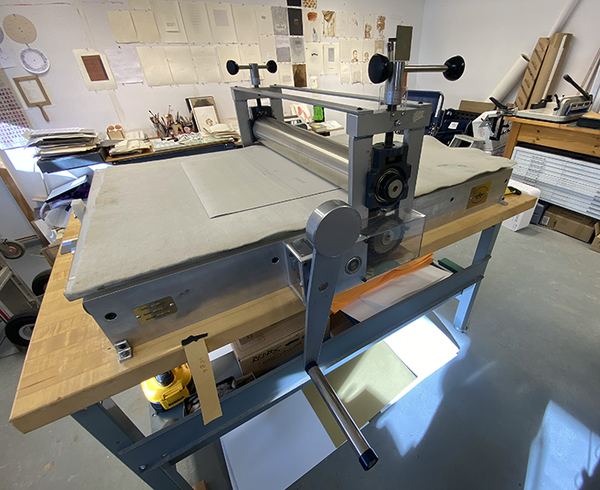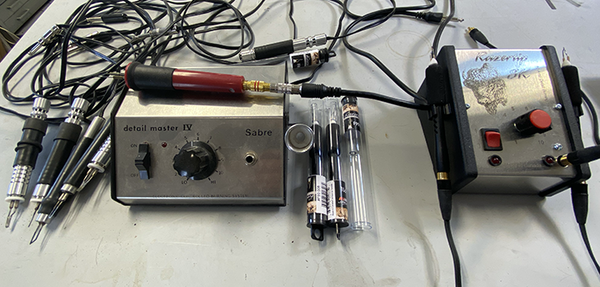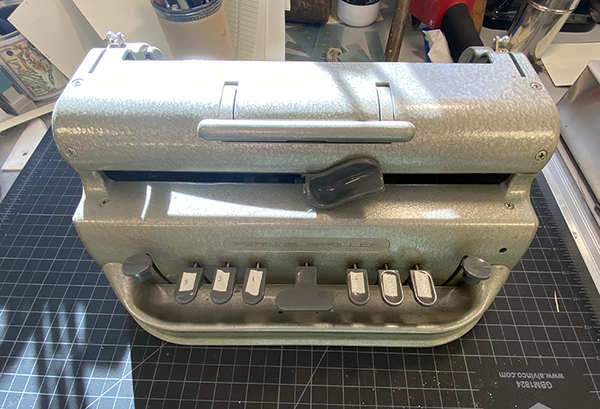What’s in my art studio? — Ed Epping
What’s in my … ? issue #134
Ed Epping‘s current body of work, CORRECTIONS (2015-present), uses drawings, sculptural forms, collages, books, and public projects to explore the social injustices of over-criminalization and mass incarceration policies within the United States. Focusing on the individuals targeted by judicial systems and social strategies, the work aims to build public knowledge by reimagining mass incarceration in the United States.
Epping’s work has consistently united the properties oftrace, delay, and proximity. Various mnemonic operations regularly incorporate homographic words that, like memory, depend upon contextual constructs to determine their multiple meanings. Homographs are defined as two or more words spelled the same, pronounced differently and mean differently; e.g., secreted, hinder, evening, unionized, number.
Granary Books has published four of Epping’s earlier projects. His work has been collected by Museum of Modern Art-Artists Books Collection, Yale, Harvard, the Center for Creative Photography, The Art Institute of Chicago, University of Chicago and the Getty Center, among others. Epping received an M.F.A. from the University of Wisconsin-Madison. In addition to teaching at Williams College (1977-2017), he has taught at the University of Illinois-Chicago and Central Michigan University. He was the AD Falck Professor of Studio Art at Williams College from 2001-2017.
Epping currently lives in Galisteo, NM.
You can find his work on www.edepping.com

A basic premise of all the work I am most intrigued by: the work examines that quality or condition which has been overlooked by most. I attempt to use that as a guide for choosing what I focus on in my imagery. So, I use words and images as partners where the word does not caption the image and the image does not illustrate the words. I privilege idea over medium because not all ideas work successfully in every medium. That often requires me to learn a brand new tool that best accommodates the image that I wish to produce, and hence I have many tools in my studio. This has permitted me to bring together processes that are not typically partnered and in that relationship build richer surfaces. The debossing and embossing of text and image into paper, like the pyrotechnic drawing, embeds the word and object into the ground…becoming part of that plane that then supports other marks. It is not surprising to find manual/electric type on inkjet printed images that have been debossed and burned…perhaps even machine embroidered. Each tool, each process brings with it a set of conventions that are enhanced by these pairings.

Bottle Jack Press
This is the second version that I made. In lieu of a bigger press, this 18 x 24” press bed with a 6-ton jack does just fine for debossing into paper. I found the plans online (now there are many DIY versions) and made the second to improve on the first. I was and remain attracted to its simplicity and low cost construction.

Takach Etching Press 30 x 48”
After a few years of using the smaller press, I decided I wanted to have a larger press bed for bigger sheets of paper. This is one of the finest etching presses made in USA and became available from a neighbor. Capable of more evenly distributing pressure than the smaller press, it permits debossing/embossing, chin collé and, of course, etching.

Wood Burning Sets
These two wood burning sets have different styluses with different degrees of fine detail. The older set, Detail Master VI/Sabre is no longer widely available and when I needed finer stylus work in my pyrotechnic drawings, I found the Razertip SK online. The lines it burns into the paper I use creates a beautifully rich sepia tone. I am attracted to the fact that the scorched mark is in the paper and not on the paper.

Perkins Braille Typewriter
I use language in much of my work and various electric and manual typewriters to reflect the different voices/time eras present in the text. I also wanted a tactile language and located this Perkins Braille typewriter on eBay several years ago. That there is language within some works only available to a few readers builds a kind of privacy into the language and its meaning.






